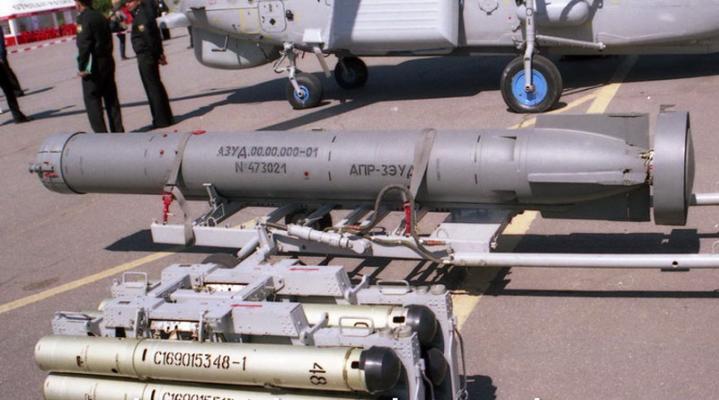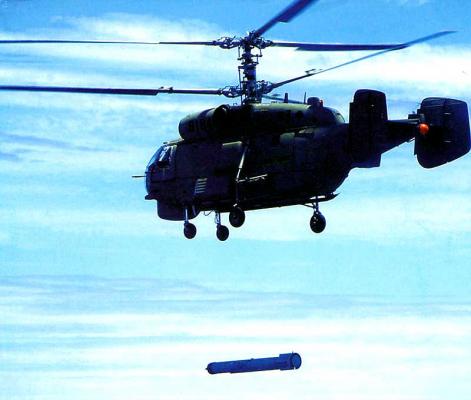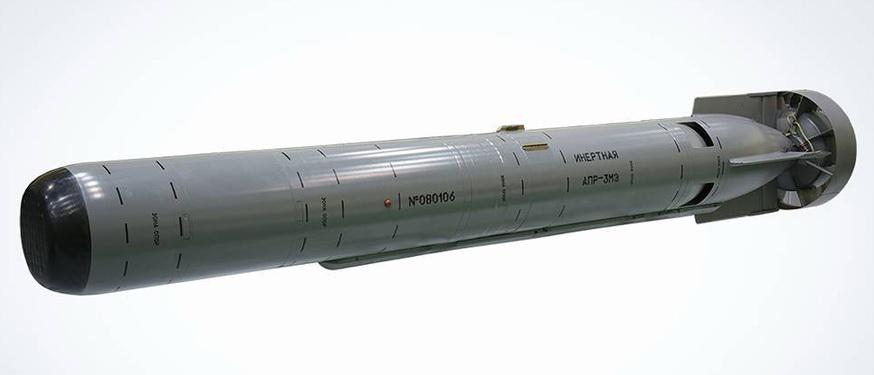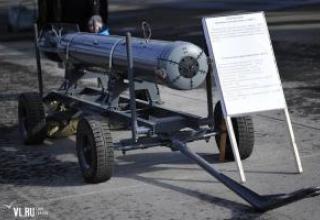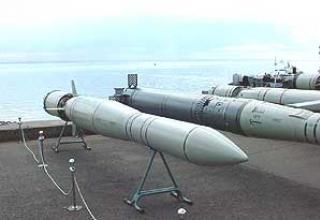APR-3/APR-3M "Oryol-M" anti-submarine missile is designed to engage modern and advanced submarines, including multi-purpose nuclear missiles, at speeds up to 40 knots in the submarine (at depths up to 800m), periscope and surface position, as well as surface ships in any water areas of the World Ocean, including in areas with shallow depths (60-150m), when the sea waves up to 6 points.
The development of the "Eagle" rocket with turbojet engine was started by NIIPGM (later Central Research Institute "Gidropribor", St. Petersburg, nowadays JSC SNPP "Region") in 1969 practically in parallel with the APR-2 "Hawk" rocket. The turbojet engine was created in the Design Bureau of "Saturn" plant under the supervision of Chief Designer A.M.Lyulka. Due to the complexity of the tasks set before the creators of the rocket "Eagle", the development time was repeatedly postponed. The development of the last version of the "Eagle-M" rocket was completed only in 1990. After it was adopted for service, the missile was designated APR-3 (export version - APR-E).
APR-3E differs from APR-2E in that it is a more efficient engine. Modernized rocket APR-3ME - further improvement of the rocket APR-3E: reduced mass and dimensional characteristics, increased range due to the operating time of the propulsion system, the response radius of the homing system increased its accuracy, speed and interference immunity, reliability of the rocket, expanded range of depths of its application. APR-3ME differs from APR-3E in the presence of an onboard integrated control system with a free inertial navigation system on a modern element base, which expands the combat capabilities of the missile as part of aircraft and marine anti-submarine systems, as well as greater ease of maintenance during operation.
The APR-3 missile and its modifications can be used:
- from Tu-142ME, IL-38 anti-submarine aircraft, Ka-28 and Mi-14 helicopters in flight or "hovering" modes according to the primary target designation data,
- as part of marine missile systems as wearable self-guided warheads with separation from launch vehicles in the air or water environment depending on the type of their basing (anti-submarine defense surface ships or multipurpose submarines), e.g. missiles 91PE1, 91PE2 of Calibre-NCE and Calibre-PLE systems.
- from standard surface ship and submarine torpedo vehicles using the missile's transport and launch container.
At present, the export version of the APR-3 missile is proposed for deliveries abroad. APR-3E is in service with the Chinese Navy.
Composition:
APR-3 is equipped with a hydroacoustic guidance system - using classification methods of information processing. Scanning of the space under water in the target search mode in silent conditions is performed by spiral motion of the rocket under the influence of gravity without switching on the propulsion system. The rocket propulsion system is activated only after target detection and allows to reach the target in minimum time (1...2 min.), which practically excludes the possibility of its evasion and/or other counteraction.
For this purpose, a number of original, progressive solutions and the latest achievements in science and technology have been implemented in the missile's design and systems. Thus, for example, in the multichannel hydroacoustic system of detection and direction finding (SOP) of APR-ZE new spatial and temporal correlation methods of processing of received signals in combination with the use of special probing parcels with azimuthal frequency modulation have been applied for the first time. The use of such parcels leads to the fact that the reverberation spectrum is wider than the submarine's target signal spectrum and this, together with the difference in space-correlation functions of reverberation and the PL target, allows to reliably adjust to reverberation interferences. At the same time, high noise immunity with respect to running interference and automatic protection against hydroacoustic countermeasures of both barrier and retransmission types are provided. Besides, in the algorithm of SOP operation gating of the target on distance, on angle in horizontal and vertical planes, floating cycle on radiation, change of duration of a probing parcel with distance are realized. The implementation of these technical solutions has allowed us to significantly improve SOP characteristics.
For the first time, the guidance law with an adaptive pre-emptive angle was developed and applied in the rocket. In the process of pointing it at the target, the value of the input preemptive angle is automatically determined, which is corrected when approaching for the purpose. Introduction of the preemptive angle in two planes is carried out by turning the axis of the directional diagram of the acoustic head electronically. The implementation of the guidance method with an adaptive preemptive angle made it possible to shift the centre of the APR-3 missile's hits to the centre of the UAV target and to ensure that it hits mainly its rugged enclosure. Thus, if APR-2 provided an equidistant range of hits throughout the entire architecture of the PL, then APR-3E not less than 50%, and APR-3ME not less than 60% of hits to the most vulnerable part of the PL (strong hull).
In the power supply system of the missile's on-board equipment, along with the use of a high-capacity ampoule battery, a molecular storage device was first developed and used. This allowed for a 7-fold increase in the electrical power consumption of the DIS sounding pulse generator with a significantly smaller storage capacity.
The two-mode turbojet engine on a mixture of high-calorie solid propellant with adjustable thrust designed for the APR-Z rocket has no analogues in the world and domestic practice. The engine running time is 113s. To reduce the impact of structural engine noise penetrating the SOP acoustic head on the rocket body, the rocket body and the acoustic head mounting units are made of noise-absorbing materials. This conditioned the SOP operability when working with a turbojet propulsion system.
The missile structure consists of individual compartments that are linked together by means of wedge joints (see diagram). A metal fairing is mounted on the nose section to protect the antenna array of the DIS loudspeaker head from shock loads at the time of actuation. The nose section of the instrument contains a DIS consisting of an acoustic head and an automatic guidance system. Acoustic head is a flat multi-element reception antenna array, whose hydrophones are combined into groups to form channels for radiation and reception. The radiation directivity diagram and the receiving view sector can be transformed depending on the conditions of the missile. The acoustic head also contains the electronic unit of the acoustic non-contact target sensor and its hydrophones, which are part of the missile's explosive device. The guidance system automat is an electronic unit that generates sounding parcels and processes signals received. The compartment of the warhead accommodates the combat charge and the safety executive mechanism of the detonator, which detonates the combat charge upon the command of the acoustic non-contact and contact target sensors.
The central instrument compartment contains the devices for control systems, on-board automation, power supply and on-board connector for electrical connections to carrier systems. The engine compartment includes a gas generator with a solid fuel charge and the engine turbo pump unit. On the front part of the engine housing there are pads, for which the APR-Z missile is suspended on the carrier. The engine is coupled with the aft instrument compartment, which houses the onboard automation units and electric steering drives. The compartment has four stabilizers with rudders located in horizontal and vertical planes respectively. The aft compartment ends with a flange for securing the braking compartment. The braking compartment consists of a body-mechanical part, parachute system and devices for putting it into operation, separation at the moment of drive and communication with the helicopter carrier when the rocket is used in the "hanging" mode.
When an ABL is detected and a decision is made to destroy it on the carrier, the APR-CE missile is prepared for combat use (see diagram). The launch vehicle is placed on the combat course and information about the flight mode and target movement parameters is entered. The missile is transferred to the onboard power sources, its control system generates and transmits to the carrier a generalized readiness signal, which is used for the reset. During the flight of the APR-3E in the air section of the trajectory there is its stabilization on a roll, opening of the brake parachute and separation at the moment of drive of the brake compartment and protective fairing. The rocket enters the water and sinks at an angle of ~15° on the differential, stabilizes on course and roll. At a depth of ~20m, the safety steps are removed and the fuse device is ready. When searching for a target to a depth of 200m, the missile plunges in a spiral without turning on the propulsion system. At greater depths, the search is performed with the propulsion system engaged. When a target is detected, the propulsion system is switched on and there is a vigorous approach and defeat. If no target is detected, the missile will self-liquidate at the end of the propulsion system.
The APR-WE rocket is supplied for operation:
- a set of equipment of STP-ZE stationary technical position, including AKIPS-3.2 automatic control station;
- sets of spare parts with main units;
- sets of training aids, including the APR-3R training and cutting missile, the A4 complex training simulator.
Characteristics:
| APR-2E | APR-3E | APR-3ME | |
| Weight, kg | 575 | 525 | 475 |
| Caliber, mm | 350 | 350 | 350 |
| length,mm | 3700 | 3600 | 3200 |
| Speed of travel, km/h | up to 115 | up to 120 | up to 130 |
| Depth of stroke, m | up to 600 | up to 800 | up to 800 |
| Parameters of hydroacoustic correlation system: - response radius, m - signal/noise resolution - bearing accuracy, hail |
up to 1500 0.4 up to 2 |
up to 2000 0.2 up to 2 |
up to 2500 less than 0.1 up to 2 |
| Battle unit charge (in TNT equivalent), kg | 100 | 74 | 74 |
| Probability of target hitting at target designation error 500m RMS, % | 70-80 | up to 85 | at least 85 |
| Time to complete a combat mission, mines | 1-2 | 1-2 | 1-2 |
Testing:
Despite the declared high effectiveness of HARM missiles of early modifications can not be considered a modern high-precision weapon because they do not have a full-fledged recognition system "insider". Thus, for example, during Operation Desert Storm, the U.S. Air Force could not always effectively use HARM missiles because the Iraqi air defense facilities, along with Soviet-made systems (against which the use of this type of missiles is calculated) included American Hawk systems.
Sources:
- Авиационная противолодочная ракета АПР-3Э
- Авиационная противолодочная ракета АПР-3Э "Военный парад"
- Энциклопедия "Оружие и технологии России". 2001г.
- Волковский Н.Л. Энциклопедия современного оружия,1997г.
- http://bastion-karpenko.narod.ru/
